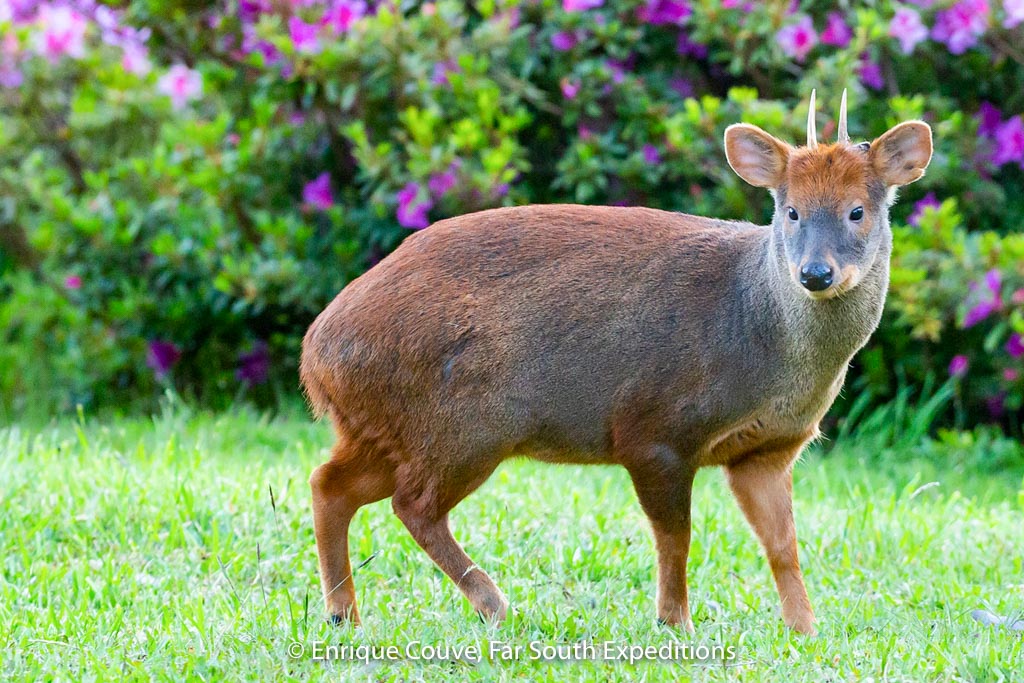During the "Chile's Best Wildlife" tour, our guides Jorge Valenzuela and Diego Olivares led a 19-day expedition in search of wildlife and Chile's most impressive landscapes. The journey spanned from the arid Atacama Desert, with its valleys and salt flats, to the lush austral forests and the Patagonian fjords and channels, home to imposing glaciers and rich terrestrial and marine biodiversity. During this trip, there was an encounter that deeply touched the participants, and that we'd like to share with you.
Chilean Deer: Diversity and Adaptation in Unique Ecosystems
According to Diego, one of the most unforgettable experiences of the tour “Chile’s Best Wildlife” were the encounters with two of the three deer species of the three deer species that inhabit Chile: the Taruca and the Pudu.
Cervids (Cervidae) are a family of herbivorous mammals that inhabit various regions of the world, from forests to grasslands and mountainous areas. In Chile, we find three native species: the Taruca or Northern Huemul (Hippocamelus antisensis), the Pudu (Pudu puda), and the Southern Huemul (Hippocamelus bisulcus).
These animals are known for their elusive and solitary nature and their highly developed senses, such as hearing and smell, which allow them to detect dangers from considerable distances. Although their vision is not as precise at long distances, their ability to detect movements within 60 meters gives them an advantage in their natural environment.
The Taruca: The Andean Deer
The Taruca, also known as the Northern Huemul, is an emblematic deer of the Andes. Males are generally larger, reaching between 74 and 91 cm in height, while females measure between 69 and 71 cm. Weight varies between 60 and 70 kg. This species is slightly smaller and has lighter-colored fur compared to the Southern Huemul.
It is adapted to high-altitude environments between 2,000 and 4,000 meters, in areas of scrubland and ravines in the Arica and Parinacota Region. The taruca is a symbol of adaptation to extreme conditions, capable of surviving in the arid and cold habitats of the Andes.
The Pudu: The World’s Smallest Deer
The pudu, measuring just 90 cm in length, 40 cm in height, and weighing around 10 kilos in its adult state, inhabits the Andean-Patagonian forests from sea level to 1,700 meters, extending from the Maule Region to the Aysén Region. In its environment of humid and shady forests, the pudu is perfectly camouflaged thanks to its thick dark reddish-brown fur.
The pudu is a shy and elusive animal, spending most of its time hidden among the dense understory vegetation. It generally lives alone or in small groups, and it’s common to see them in pairs in the most remote areas of the southern forests.
The Fascinating Antler Renewal in Deer
In many deer species, males develop antlers, bone tissue structures that play a crucial role in their life cycle. These antlers are not just an impressive visual feature but are fundamental in male competition during mating season: they serve to establish dominance and access reproduction opportunities.
The process of antler shedding and regeneration is one of the most impressive in the animal kingdom. Antlers appear in animals older than one year, originate from the frontal bones of the skull, and are initially covered by a fine skin called “velvet.” Each year, males lose their antlers at the end of the reproductive cycle and develop new ones before the mating season begins. The shedding occurs when small empty spaces form at the base, weakening until they detach, a process influenced by hormones, especially **testosterone,** which regulates both their growth and detachment at the end of the reproductive cycle.
Antlers can take different forms depending on the species:
– Simple, as in the case of the Pudu
– Forked, like those of the Taruca, which usually reach up to 35 cm
– Highly branched, in other larger species such as moose or red deer
This annual renewal process is not only a spectacle of nature but also a testimony to the regeneration and adaptation capacity of these fascinating animals. Another reminder of wildlife’s incredible diversity!
Highly Threatened Species in Chile
Both species are included in the IUCN Red List: the Taruca is categorized as “Vulnerable”, while the Pudu is classified as “Near Threatened”. The Taruca and Pudu face common threats in Chile: habitat loss and degradation, caused by human activities such as deforestation, agricultural and livestock expansion, and infrastructure development; attacks by feral dogs; diseases transmitted by domestic animals; and poaching.
However, there are differences in the challenges they face. The Pudu is more affected by the fragmentation of native forests in the wetter southern regions, while the Taruca faces from direct competition with livestock in the more arid Andean ecosystems.










Leave a Reply
Your email is safe with us.